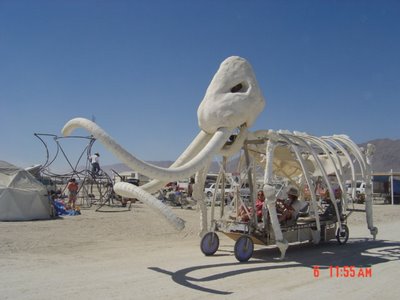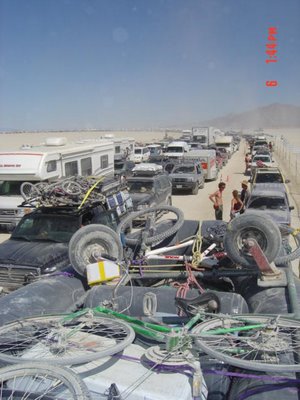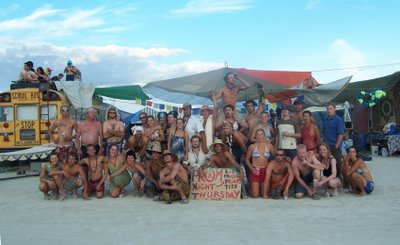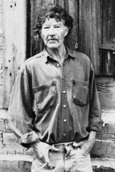
The Herald Magazine: Burn Baby Burn!
by Jamie M Johnston
My friend, wearing Stetson, flip-flops, shorts, goggles and with painted chest, turns to me and says, “Let’s get on the Dragon Bus.” “Where does it go?” I ask naively. “I have no idea,” was the suitably vague reply.
Five minutes later the driver of the Dragon Bus, an eighty foot construct of wheels and trailers fronted with a steam train and seats for one hundred crazies, looks back at me cross-eyed and screams, “Your not in Scotland now!”
Neither, it is Burning Man, the annual free-form arts festival founded by
For one week only Black Rock City becomes the third biggest city in Nevada with figures of around 30,000 in attendance. It is situated some 120 miles northeast of the gambling, strip club, neon lighted Reno where most stock up on supplies for the week.

The best information to be found on the event is at www.burningman.com. The site comes fully loaded with essays, pictures, ideas and documentation of previous Burning Man festivals.
For outsiders who see Burning Man as a hippy fest of long hair, little amount of clothes, and pagan like dancing around huge bonfires, the incorporation of up to date technology in the art and in the running of the festival may come as a shock.
The ethos at work, according to the site, is that “Burning Man is an annual experiment in temporary community dedicated to radical self-expression and radical self-reliance.” This covers the main three areas at work in Burning Man.
The first, temporary community, means that one has to stay and immerse one’s self in the event. Here you can only be a participant. There are no spectators. Signalling this is the fact there are no day passes sold or discounts offered for partial duration.
To feel the true essence you have to become part of the community that is based on giving and sharing where you need and rely on others whom, in turn, need and rely upon you.
Secondly there is radical self-expression. Every year is themed and this year’s was the Vault of Heaven. But Black Rock City is a semicircle of smaller themed camps created by the citizens themselves.
They ranged from a car with tent that offered a chance to throw darts at pictures of the Royal Family (hugely popular) to a giant canopy with living quarters for twenty boasting a Full Contact Croquet League.
The atmosphere changes with your location. If you want madness go and fight your friend in the recreated Thunderdome, or chat amicably with strangers in centre camp, or dance like a madman at Disturbia, or simply stare at the sky peacefully in The Mausoleum with 360-degree alien desert noises.
No money is made from the festival. People are stripped of their creature comforts and normal social boundaries are left back in Reno. People wander freely completely naked, or paint themselves blue. Some come in their RVs. Some have a tent. But everyone becomes equal due to the saturation by the playa dust that gets in your food, in your bed and sooner or later, into every orifice.
To come unprepared is suicide. Sure you can swap a few things for some food and water. But who do you call on when it is 107 degrees and you have no shade, when the wind picks up to 70mph and your tarp whisks off into the sky, or when during the night the temperature plummets and your shorts and t-shirt are no longer adequate.
There is a reason for Burning Man being situated where it is. Here the elements are harsh and unforgiving. One has to look after one’s self and then look to the fellow man. There is no vending. The community shares and thrives.
To get around this vast 400 square mile dried up riverbed one should really bring a bike, moped, or trumped up lawn mower. My only brush with authority came when riding my moped. Unbeknown to me vehicles can only be used if they are licensed art vehicles. So after a facelift for my moped I went to the local DMV – the Department of Mutant Vehicles – to register my new vehicle.
To be honest this is the only kind of pressure to be found at Burning Man. The need to conform to nonconformity. You are not normal, or part of the crowd, unless abnormal. Funny then that
As with any major contemporary festival drugs are rife and easy to get hold of. However, with so much man made visual stimuli on offer suffused with the natural dramatic backdrop of open desert and clear sky a natural high pervades the mood.
Multitudes of workers and helpers arrive and leave sometimes months before and after the thousands of Black Rock citizens. Although the festival proper begins on a Monday and climaxes on the Saturday night with the burning of The Man, a forty-foot wooden construct atop an altar that towers above it all.
The climax approaches. Out in the playa the citizens gather around The Man. We are treated to a spectacular fire show with various Mad Max-like vehicles shooting balls of multicoloured flame at The Man and leather-clad fire-dancers spinning poi to a hypnotic drum beat.
With a full moon competing for attention the crowd chants “Run Burning Man Run”, until the whole neon effigy becomes a giant bonfire. As The Man collapses to the ground, the crowd rushes in screaming to dance madly around the white-hot embers, throwing in material possessions and things of sentimental value.
For the rest of the evening the citizens waltz from one fire-show to the next. The art projects dotted around the playa, carefully laboured on for the best part of a year, are quickly burned to the ground. When I saw a hundred foot matchstick-made cathedral go up, it burned so white it felt like my eyeballs would melt.
This year’s theme asked a few questions: Where does everything come from? Where does everything go? And where and how, in this vast scheme of things, do we fit in? While sitting in a field of flapping flags with nothing else in sight I plucked up the courage for one brief moment – I’m British – to strip off and sit and contemplate my existence like Hugh MacDiarmid on his raised beach, or more aptly, Rilke in the Arabian desert.
Although Black Rock City disappears physically every year, people never leave quite the same. Everyone is talking a little piece of Burning Man back to his or her prospective realities. The Burning Man website acts as a gateway into the ever growing matrix of sites created by participants over the years who wish to prolong the reality at work in Black Rock City.
Along with this we now have Danger Ranger’s journey through America that is being documented on the website. This “Mystic Shaman Cowboy” has a mission to cut short the anxiety felt by the citizens of Black Rock after the Burning Man event when they realise that they have another 358 days to wait until the community is reunited once again.
“Danger’s message to you is that you need no longer wait. Take what you have learned from your experience, organize with friends and fellow burners, and be ready to greet him.”







